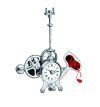| Page
15 The most beautiful ... stupidity !!! |
 |
||
| The prize of the most beautiful nonsense goes undisputably to Sébastion Bohler in La Chimie de nos émotions (Aubanel) | |||
| At
page 110, you'll find an article entitled Le
Boléro de Ravel, oeuvre de la folie ? (the Bolero, a work of
a mad spirit) I discharged you of reading the first part, describing the Bolero, that you probably know, but the following passage is too tasty for my amputating it of anything : |
|||
|
"Several years
ago, neurologists from the Paul Broca Centre, looked over all the
documents dealing with an eventual desease which Ravel would have
suffered at the end of his life, when he composed the Boléro.
Ravel would have been affected, for mysterious reasons, by lesions of
the left hemisphere of the brain. Now, the conception and the
perception of melody are precisely carried out by the left hemisphere,
whereas the perception of tone (timbre) is made by the right
hemisphere. Therefore, Ravel was in the incapacity of creating in
regard to melodies when he composed the Boléro.
He had his melody readymade, but he could no more modulate it. On the
other hand, his healthy right hemisphere could permit him to vary the
nature of instruments and the timbres playing this melody. From that
comes a piece based on enrichment of timbres upon a single musical
motive.
What have been called the work of an ill spirit was in fact a spirit that used the best of its left musical abilities." |
|||
|
1° )Better
leaving a specialist answer to Mr Bohler . Erik Baek writes :
|
|||
|
"Maurice
Ravel (1875-1937) suffered from a presenile, progressive neurological
disorder which annihilated his creativity in his final years. He died
after craniotomy but only specultive retrospective dignoses are
possible since autopsy was not obtained. Nevertheless, it is likely
that Ravel's illness belong to the so-called Pick complex, which
includes frontotemporal dementia, primary progressive aphasia and
corticobasal degeneration. There are no valid arguments for an alleged
influence of this disease on the style of Ravel's last compositions."
|
The Terminal Illness and Last Compositions of Maurice Ravel. Erik Baeck, in Neurological Disorders in Famous Artists, Frontiers of Neurology and Neuroscience, vol 19 Basel, Karger, pp132-140. From Mr Baek, see also, on the same subject, Ravel studies, (Cambridge Université Press). | ||
|
This excerpt of a
9 pages article (2005) is clear. And Erik Baek is not only neurologist,
but also a musician...
|
|||
| 2°)
Having studied in Polytechnique, doctor in neurobiologoy, Mr
Sébastion
Bohler should have listened more of Ravel's music, or, eventually, read
a little about him.
He surely would have noticed that the two marvelous piano Concertos were
composed later than the Boléro...
and that they show no melodic inability (on that subject, he could read
in The Watchmaker's heart,
an analysis of the fascinating melodic evolutions of the first movement
in the G Concerto...). |
|||
| 3°) Ravel has said
that he had been influenced by Poe's
Philosophy of
composition where M. Bohler would learn the predominance
of the refrain-principle. Hadn't Ravel called the last movement of his
violin sonata Perpetuum
mobile
? More surprising is the existence of a secret dedication in Ravel's music, but no less obstinate |
|||
| 4°)Finally, one has to mention, what Mr Bohler omits : Ravel knew lately that he could not orchestrate Albeniz's Iberia for his friend Ida Rubinstein. He had to compose something in only several weeks although he was habitually so slow to create ! | Joaquin Nin, Comment est né le Boléro de Ravel, La Revue musicale, December 1938. | ||
| As we see, this work that some called a work of a mad spirit is in fact a good example of pragmatism ! |
David
Lamaze
Le Cygne de Ravel ~ Le Coeur de l'horloge
Le Cygne de Ravel ~ Le Coeur de l'horloge